Leadership Project
Overview
My leadership project focused on access to higher level courses (college prep and honors/AP/IB) for all students, with a specific focus on our Latino population. To accomplish this task, there were 2 components to my project, a policy analysis aspect that analyzed the protocol teachers use for recommending students in to these courses as well as the placement of students in classes by the guidance office. The second element of my project was the cultural awareness element, that aimed to create an awareness for all students of what the college preparatory and higher level course curriculum is on our campus and how to access it.
My Role
Policy Analysis: This tenet of my project sought to explore any barriers that students encounter when trying to access college prep (CP) and higher level course at MVHS that may be embedded in systemic policies. In order to accomplish this, I decided to focus on both recommendation policies and practices (teacher actions) as well as placement policies and practices (guidance office/student actions). The purpose was to examine and uncover any inconsistencies in either process that may be serving as barriers to students trying to access the higher level curriculum.
 Activity 1: Review comparisons and contrasts between departmental policies for course recommendations in to Spanish 2 (CP) and AP Spanish and what criteria teachers actually use for this process.
Activity 1: Review comparisons and contrasts between departmental policies for course recommendations in to Spanish 2 (CP) and AP Spanish and what criteria teachers actually use for this process.
In order to accomplish this I solicited feedback from the Spanish 1 teacher as to what criteria they used in order to recommend their students on to Spanish 2 during the recommendation process that occurs in the spring for the following academic school year. Because I wanted complete honesty, I felt that anonymity when responding was key so that teachers didn't feel they were being judged and would feel more open to share their actual practice. In order to accomplish this I created a link to a Google form that could be accessed without needing any log-in information or any other identifiable info. Once teachers accessed the link they were asked one open-ended question: "What are the necessary requirements in order for a Spanish 1 student to be recommended on to Spanish 2?". Google then generated a spreadsheet with all teacher's answers without any identifiable info. as to who had answered what. I then compared their answers with department policy to uncover any inconsistencies. I followed the same process to solicit information from Spanish 3 teachers and the recommendation process into AP Spanish.
Findings: After comparing the teacher's responses to department policies, inconsistencies were found in the recommendation process into both CP and AP classes in the World Languages Dept. At both levels, some teachers did not adhere to department policy by either requiring a higher, or lower, grade than is stated in department policy as a basis for student recommendation into the course. Additionally, some teachers require additional specific language skill requirements of the students before being recommended on to the CP or AP course, which is not part of the department policy.
Implications/Barriers/ Next Steps: Because of the inconsistencies being followed by teachers in the recommendation process, some students have a more difficult time accessing the higher level curriculum on our campus dependent on who their teacher is for the prerequisite courses. I believe the next step is to review department policies with all World Language teachers as well as re-examine them in order to determine if changes need to be made, or if the current policy is consistent with providing access to all students.
Activity 2: Review comparisons and contrasts between Guidance department policies for course placement with a teacher recommendation and what criteria the Student Services Technicians (SSTs) actually ue for this process.
The purpose of this activity was to examine the protocol for what course to enroll a student in when he/she does not want to take a CP (Spanish 2) or AP course, even with a teacher recommendation. I wanted to see if a student was allowed to drop a higher level class at their own discretion, or if there were policies and practices in place in the guidance office to encourage students to remain in these courses. I followed a very similar process as activity 1, soliciting the protocol that the guidance techs use for this scenario by having them fill out an anonymous Google form that asked them "What is the protocol for when a student receives a recommendation into Spanish 2/AP Spanish, but he/she decided that they do not want to take that class?". I then compared their answers to the guidance department policy on this protocol.
does not want to take a CP (Spanish 2) or AP course, even with a teacher recommendation. I wanted to see if a student was allowed to drop a higher level class at their own discretion, or if there were policies and practices in place in the guidance office to encourage students to remain in these courses. I followed a very similar process as activity 1, soliciting the protocol that the guidance techs use for this scenario by having them fill out an anonymous Google form that asked them "What is the protocol for when a student receives a recommendation into Spanish 2/AP Spanish, but he/she decided that they do not want to take that class?". I then compared their answers to the guidance department policy on this protocol.
Spanish 2 Results AP Spanish Results
Findings: After comparing the SSTs responses with guidance department policies, inconsistencies were found in the protocol for allowing students to drop/un-enroll in a higher level course they were recommended for. While department policy is followed when students try to drop a CP course, one SST also requires the student to speak with a guidance counselor before wing allowed to drop. When looking at AP course placement, both respondents also follow guidance policy, however one encourages students to "try" the course for a few weeks before being allowed to drop.
Implications/Barriers/Next Steps: While the Student Services Technicians follow department policies of allowing students to un-enroll in a CP or AP course by counseling the student and requiring a parent note, at both the CP and AP levels, one of the SSTs also requires additional steps before allowing the student to drop the class. This results in some students being allowed to drop important course more easily than others dependent on who their SST is. While no barriers were discovered in the placement (or non-placement) process used by the guidance office, it behooves them to re-assess current policies. They may want to consider implementing the protocol that one of the SSTs uses of encouraging students to try taking the higher level courses they were recommended for for a few weeks before being allowed to drop it. The student may discover they want to continue in the course after giving it a try.
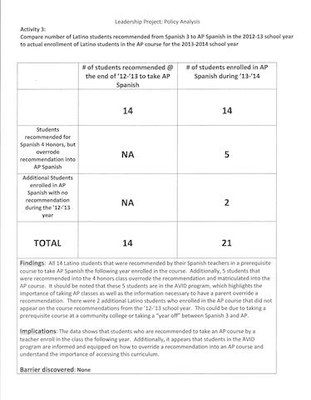 Activity 3: Comparing number of Latino students recommended from Spanish 3 to AP Spanish with actual enrollment.
Activity 3: Comparing number of Latino students recommended from Spanish 3 to AP Spanish with actual enrollment.
The purpose of this activity was to analyze any barriers students perceived or encountered when trying to access the AP curriculum, even with a teacher recommendation, resulting in them not enrolling in the course. In order to accomplish this, I reviewed all of the Latino students that were recommended at the end of the 2012-2013 school year to take AP Spanish by their Spanish 3 teachers with the actual enrollment of Latino students in the AP course during the 2013-2014 year.
Findings: All Latino students that were recommended into the AP Spanish course enrolled in it the following year. An additional 5 Latino students that were recommended into the 4 honors course overrode the recommendation and matriculated into the AP course, resulting in a higher number of Latino students taking the AP course than were recommended.
Implications: The data shows that students who are recommended to take AP Spanish by a teacher enroll in the class. Additionally, as the 5 students who overrode the recommendations in order to take the AP class are all AVID students, it appears that these students are well-informed and equipped on how to override recommendations and understand the importance of accessing this curriculum.
Cultural Awareness: The purpose of this tenet of my project was to create an awareness for all stakeholders of the a-g requirement (CP and higher-level courses) and the differences between these classes and graduation requirement courses. I also hoped to gain an understanding of some of the perceived/actual barriers on campus in accessing these courses.
Activity 1: Project a-g; the purpose of this campaign was to create an awareness for all stakeholders of what the a-g requirement is, it's importance, the implications of to being "a-g eligible" and the courses on MVHS's campus that satisfy the requirement. In order to accomplish this I,
- Created an "a-g" poster that serves as an educational piece for both faculty/staff and students explaining the a-g requirement and the courses on campus that meet it. This poster has been put in every teachers's classroom as well as the guidance office and various common area locations. The purpose is to not only create an awareness of a-g, but also spark conversations between teachers and students about accessing the required courses. (additional evidence)
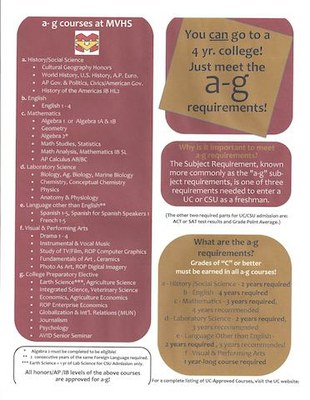
- Held parent and student meetings to explain and discuss the a-g requirement
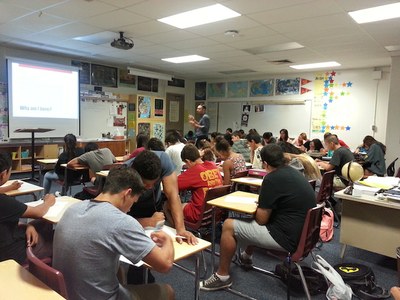
- Created a letter to send home to parents in both English & Spanish explaining the requirement as well as copy of the a-g poster created that lists all courses at MVHS that are a-g.
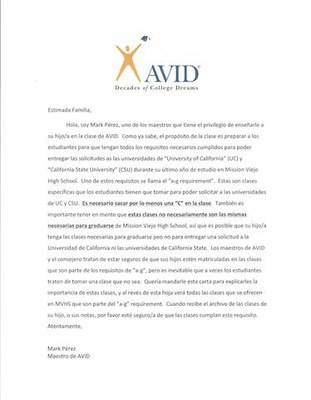
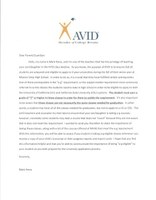
Activity 2: Exploring perceived/actual barriers on campus in accessing the a-g curriculum. The purpose of this was to gain an understanding of barriers prevalent on campus as perceived by teachers. This was accomplished by asking teachers at a faculty meeting to come up with a list of why they think students can't, or are not, accessing this curriculum. They were asked to discuss this issue with their peers in group of 5-8 and generate an anonymous list of perceived and real barriers.
Findings: After receiving all of the responses, I sorted all of the different reasons teachers listed for students not accessing the a-g courses into three categories of barriers: academic, deficit and systemic. Some academic barriers included lack of early academic interventions and academic preparation. Under systemic barriers some specific issues included a flawed recommendation process and staff inconsistency. Deficit barriers included lack of mail support, intrinsic student motivation, etc. Academic and systemic barriers accounted for 26 total responses, while deficit barriers accumulated 22 responses.
Implications/Next Steps: I decided to focus on systemic barriers by analyzing recommendation and placement procedures and policies in the Policy Analysis portion of my Leadership Project (see above). For both systemic and academic barriers, I decided to use the a-g campaign portion of my project to educate and create awareness for all stakeholders. I believe to focus on the deficit barriers, or the beliefs that not all students are capable of taking higher level courses, a complete shift in culture is needed on our campus. I have begun to try to tackle this by implementing a college-going culture that motivates students and help them to begin talking about college and the necessary requirements to be admitted to a 4 year university (see College Going Culture Campaign)
CPSEL Connection
CPSEL 1: Facilitating the development, articulation, implementation, and stewardship of a vision of learning that is shared and supported by the school community.
- 1.1 Develop a shared vision
- 1.2 Plan and implement activities around the vision
- 1.3 Allocate resources to support the vision
CPSEL 2: Advocating, nurturing, and sustaining a school culture and instructional program conducive to student learning and staff professional growth.
- 2.1 Develop school culture and ensure equity
CPSEL 3: Ensuring management of the organization, operations, and resources for a safe, efficient, and effective learning environment.
- 3.2 Create an infrastructure to support an effective learning environment
- 3.4 Monitor and evaluate the program and staff
CPSEL 4: Collaborating with families and community members, responding to diverse community interests and needs, and mobilizing community resources.
- 4.1 Collaborate to incorporate the perspective of families and community members
- 4.2 Establish and manage linkage between the site and the larger community context
CPSEL 5: Modeling a personal code of ethics and developing professional leadership capacity.
- 5.1 Maintain ethical standards of professionalism
- 5.2 Guide sound courses of action using pertinent, state-of-the-art methods
- 5.3 Sustain professional commitment and effort
CPSEL 6: Understanding, responding to, and influencing the larger political, social, economic, legal, and cultural context.
- 6.1 Engage with the policy environment to support school success
- 6.2 Interact with stakeholders

